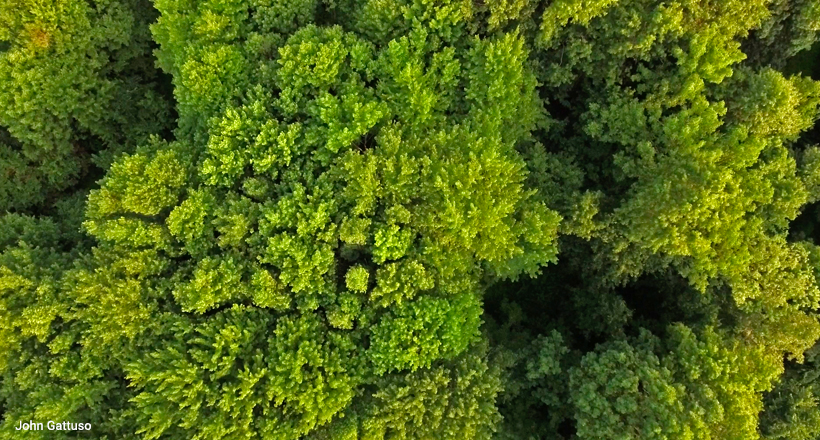CLIMATE CHANGE MITIGATION
Protecting Forests That Help Fight Climate Change
TOM GILBERT / NJ CONSERVATION FOUNDATION – In the fight against climate change, some of New Jersey’s most powerful weapons are tall, green, and leafy.
Trees, through their natural process of photosynthesis, pull harmful carbon dioxide from the air and emit oxygen. Carbon gets stored in the wood, roots and surrounding soil, keeping it out of the atmosphere, where it traps the sun’s heat like a greenhouse.
The Earth’s warming from excessive greenhouse gases is leading to sea-level rise, increased precipitation, and more extreme and deadly weather events. These changes have major impacts on public health and safety, infrastructure, and the economy.
New Jersey is now looking toward forests and other “natural and working lands” as a key part of its strategy to address climate change.
While all trees sequester carbon, scientific studies increasingly show that mature forests do it best. One study in the Northeast found that forests over 170 years old supported the highest levels of carbon storage, timber growth, and species richness. Nearly all New Jersey forests are many decades younger, and they will mature and store carbon at rapid rates for a long time to come – if we let them.
For a small, densely populated state, New Jersey is rich in forests. The state is 42 percent forested, with 62 percent of those forests on public lands.
But our forests face many threats, including overabundant deer, invasive plant species, and insect pests. For maturing forests with large, healthy trees, another potential threat comes from inappropriate commercial logging on public lands.
Active forest management on public lands is sometimes needed to address threats such as disease and pests, and reduce the risk of catastrophic wildfires. However, New Jerseyans may be surprised to learn that commercial logging that has nothing to do with reducing threats to forest health is sometimes conducted on our public lands, including state, county, and even municipal parklands.
How to protect our public forests – including those sequestering the most carbon – was the topic of an online expert discussion this week, organized by the New Jersey Highlands Coalition.
Elliott Ruga, policy and communications director for the Highlands Coalition, noted that officials at all levels of government can be tempted by the potential revenues from allowing forests to be commercially logged. These revenues can help plug budget holes, defraying taxes.
But is logging revenue worth the sacrifice?
Ecologist Leslie Sauer, author of The Once and Future Forest, noted that mature, intact forests are far more valuable for carbon sequestration and other ecological services than they are for logging.
“It’s hard to overstate how serious the issue of climate change is,” Sauer told the online audience of about 360 people. “The bottom line is that nothing sequesters carbon better than a forest. We need to manage our forests as carbon reserves.”
Sauer and many other ecologists favor “proforestation” – leaving maturing forests in their natural state without active management – to reach their highest potential for carbon storage. New Jersey should identify areas of intact, maturing forests on public lands where proforestation is the management priority.
Dr. Emile DeVito, staff ecologist for New Jersey Conservation Foundation, said that although New Jersey currently has relatively little commercial logging on public land, the pace could increase in the coming years. The vast majority of public forests are not protected from commercial logging and there are relatively few “natural areas,” a state designation that would provide greater protection.
DeVito noted that New Jersey has virtually no virgin, old-growth forests left. The state’s oldest forests, at 130-plus years old, are barely middle-aged. “Our healthiest, maturing forests will sequester carbon at rapid rates for more than another century. We need to set most of them aside as carbon reserves or natural areas, and concentrate our active forestry management efforts on degraded forests in need of ecological restoration,” DeVito said.
Jay Kelly, a professor at Raritan Valley Community College who studies northern and central New Jersey forests, said many forests are failing to regenerate because deer devour saplings and young trees before they reach a safe height. Deer populations have been exploding since the 1970s, he said, and overabundant deer remain the greatest threat to forests’ ability to fight climate change. Our forests desperately need strong measures that successfully reduce the deer population.
State Senator Bob Smith, Chairman of the Senate Energy and Environment Committee, agreed that state policy needs to be revised to give a higher standard of protection to publicly owned forests.
One reason the Earth’s climate is warming so quickly, he said, is because “we’ve been attacking forests all over the world. We’re going the wrong way, worldwide, on forests.”
The New Jersey Department of Environmental Protection is looking toward forests and other “natural and working lands” as part of its multi-pronged strategy to address climate change.
Governor Murphy recently signed an executive order to reduce greenhouse gas emissions from all sectors 50 percent by 2030.
A natural and working lands strategy will help! New Jersey’s forests and other natural and working lands currently store the equivalent of eight percent of the state’s annual greenhouse gas emissions. The state is counting on increasing the carbon stored in forests, wetlands, and agricultural soils.
In December, the New Jersey Departments of Environmental Protection and Agriculture jointly released a scoping document describing the ways these lands can store more carbon. The agencies are taking public comments through Feb. 11, and a comprehensive plan is expected be completed before the end of the year.



 Angel Alguera
Angel Alguera Daniel Gilkeson
Daniel Gilkeson Benjamin Goldberg
Benjamin Goldberg Surya Jacob
Surya Jacob Vineesh Das Kodakkandathil
Vineesh Das Kodakkandathil Douglas Leung
Douglas Leung Nihar Mhatre
Nihar Mhatre Justin Morris
Justin Morris Josephine O’Grady
Josephine O’Grady Jessica Parineet
Jessica Parineet Dillan Patel
Dillan Patel Moira Sweeder
Moira Sweeder